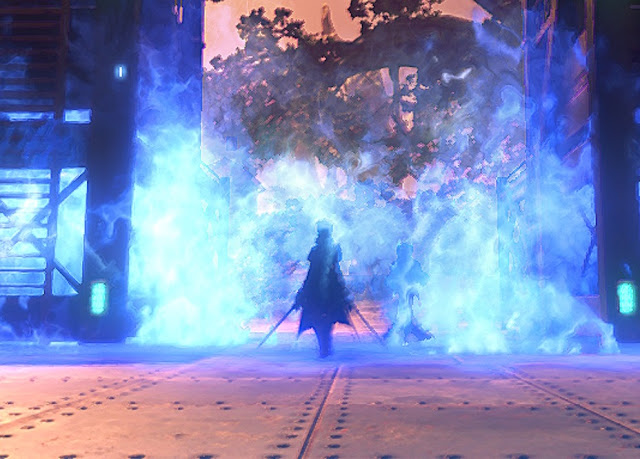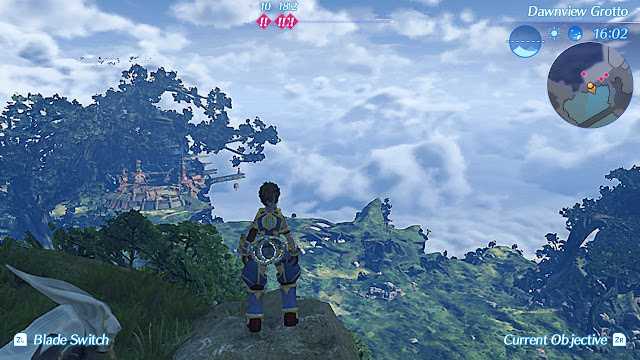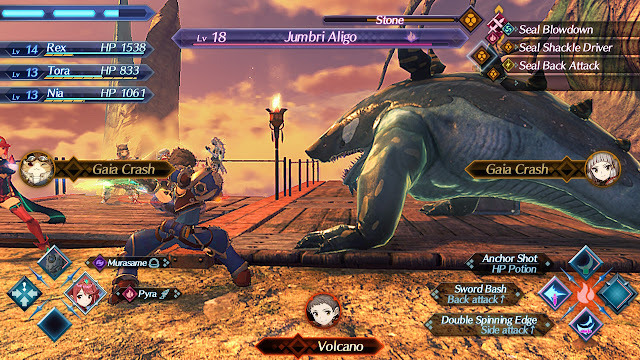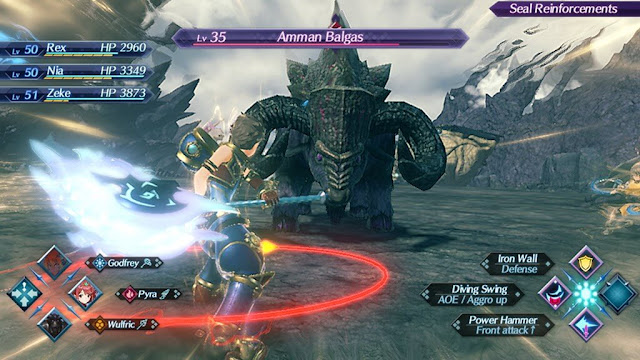Review by Matt S.
I don’t think I’ve played a game that manages to misfire on tone quite as much as Xenoblade Chronicles 2. I preface this review by saying that on a fundamental level it’s an incredibly enjoyable game, and, as the first true big-budget JRPG on the Nintendo Switch it has set the standard for what we can expect from the genre on the console. And indeed, handheld gaming in general. We’ve never had something quite like this for on-the-go play, and that in itself is amazing. But at the same time I spent most of my playthrough being utterly bewildered by some of the narrative directions Monolith took its latest epic.
The best way I can describe Xenoblade Chronicles 2 is as a game that’s really two narratives that have been awkwardly laid on top of one another, in a way that doesn’t really work. On the one hand you’ve got a story that’s at least as complex, nuanced, and fundamentally beautiful as the original Xenoblade Chronicles. There are some powerful themes in there around spirituality and the search for a higher being. There is poignant and timely commentary around environmentalism, too; the world is covered in a thick, unlivable fog sea, and people can only exist on the back of titans that rise above the fog. But the titans are dying, and the world is preparing for war over what little land remains. If you don’t see the parallels there with climate change in the real world, you’re simply not paying attention, because it’s a core message that they game wants you to take away from it.
The very basis of the adventure itself is that the heroes are on a search for “Elysium,” a place that sits on top of the world tree (i.e. Yggdrasil), and was a place that humans were expelled from for doing, well, what humans do. This place, which no one is actually certain really exists (aside from the protagonist and his “blade” companion, who claims to be from there and is very much a messiah-like being) is seen as a potential salvation for the remaining humans before the last of the titans die, taking all life with them. The parallels here with the paradise of Heaven and the religions of the people of the book is quite explicit, and while the game isn’t preachy about it (especially considering it comes from a country that doesn’t really participate in those religions), and without giving away spoilers, it nonetheless draws some universal truths about the human condition, morality and spirituality out of it.
When the game dips into these topics its remarkably earnest and honest about it, too. The voice acting is a bit of a misfire, mostly on account of too many of them sounding like rejects from Guy Ritchie films, though the Japanese voice track addresses this. But beneath that is a story that’s both emotionally and intellectually engaging. I was certainly searching far less for the greater purpose of this game’s story compared to its two immediate forebears, and those moments represented a definite, crystal clear step forward in the maturity of Monolith Software’s storytelling.
Because the game is so narrative driven, too, once I got over the bad English accents, I found the interactions between the characters to be quite endearing too. It’s an eclectic bunch that join your crew in Xenoblade Chronicles 2, but their personalities work off one another quite wonderfully, so, purely on the storytelling level, I found myself pushing on because I was enjoying the group dynamic and their quest on that fundamental level.
But all this then clashes heavily with the juvenile humour and fanservice, which comprises the other half of the game. Gags that you’d expect from any standard harem game come in abundance, and there’s an awful lot of attention placed on the anatomy of the various female bodies, what they’re wearing, and their physical appearance. We’re talking gutter humour to the point where in one scene, a male character wakes up to a face filled with DD-sized boobs because of course that’s funny… that same girl then becomes the butt of weight jokes – which is oh-so-funny because she is, of course, actually gorgeous. Previous Xenoblade games have had elements of this, but Xenoblade Chronicles 2 takes it to a different level entirely.
Now, before anyone yells at me for being a prude; go read some of my other reviews. Whether it Dark Rose Valkyrie, Hyperdimension Neptunia, School Girl / Zombie Hunter or Dead or Alive, I’m all for fanservicey games. Give me a girl in her underwear and I’m having a great time. So, no, it’s not the presence of that stuff in Xenoblade Chronicles 2 that bothers me. In fact, “bothers” isn’t even the right word. I’m not so much annoyed with the fanservice as I am confused by it. As fellow DDNet author, Matt C, made a joke about (but one that oddly fits), it’s an example of lewdonarrative dissonance (https://twitter.com/MC_Odd/status/935371692985139200). It’s like if you took a tonally serious JRPG, like Final Fantasy XV, and shoved random scenes of Hyperdimension Neptunia’s frequent boob jokes in there, without any genuine context to the rest of the narrative, because it would be “funny”. It’s incredibly inconsistent, and it doesn’t work to the game’s favour at all. A title like Persona 4 or 5 does a far better job of mixing in fanservicey moments with a serious plotline, because the two threads are woven together with far greater consistency. Xenoblade Chronicles 2 seems to be more a case of splitting the narrative in two and cutting back and forth between a “serious” moment and a “ecchi and humour” moment, without the incredibly fine legs and midriffs of the many lovely ladies actually contributing to the game in a meaningful manner.
I was never quite able to resolve the narrative consistency within Xenoblade Chronicles 2, but despite that I did have a really good time with the game itself. The combat is particularly delightful. Anyone who has played the previous two Monolith games would know basically what to expect; the game behaves a little like an MMO in that each character will auto-attack an enemy until a special attack bar fills (by successfully landing attacks), and those special abilities can be used for everything from dealing massive damage to an enemy to inflicting specific status conditions, or perhaps healing your own party. These abilities are provided through “blades” – such as the female character mentioned above – which are humanoid (or animaloid) creatures that don’t directly fight, but rather support their partners by providing them with their specific special abilities. You can set a few of these blades to each character and then wade into combat able to switch between them, which gives you plenty of different options to adjust your strategy on the fly, depending on the enemy that you’re facing.
The “blades” are the new feature to Xenoblade Chronicles 2, and there are a lot of them to collect through the game. It’s a system that had the potential to add too much to an already very functional JRPG combat system, but as it turns out, the system works well, and hey, the blades are cute enough.
While the combat is great, the exploration side of Xenoblade Chronicles 2 is less so. The world is not as big and bloated as we saw in Xenoblade Chronicles X, and that’s a good thing, but the quest structure still has you running all over the place on fetch quests that do nothing beyond adding to the number of hours this overly long game takes to complete. Dumping players with the task tracking down 12 obscure roots, which drop at random from plants in the overworld, is not a particularly good way to ask for a time commitment from them. It works fine as side quests for people that want to see and do everything, and don’t care whether they’re getting narrative or just more content, but it’s tiring busywork and for those of us that are over content in the game and just want to enjoy the story. This kind of stuff should never be part of the main narrative.
The game’s better in its more focused dungeons for that reason. There’s usually a bit of light puzzle solving, as well as the chance to veer off and indulge in some treasure hunting. Monolith has a really good sense of the precise timing with which to throw new enemies and challenges at players through a dungeon, and boss battles are energetic and prolonged experiences that allow for a lot of tactical thought. It’s just a pity that there’s so much busywork held within the main quest in between those dungeons.
The other issue the game has is that it doesn’t handle the small screen of the Nintendo Switch so well. In cut scenes and when the camera is panned in close, the game’s a delight. There’s a real eye for detail in sets and characters, right down to regional architecture and fashion, and these small details help make the world feel all the more epic, that it has the scale for the people from different parts it to have developed cultures of their own.
I also really enjoyed the way the world itself – and thus the exploration of it – would wrap around the titans. It really does create the most brilliantly distinctive landscapes to explore to see the giant head off in the distance, or to walk along one of its appendages to gain access to a warship from below. This approach to world design is something that the original Xenoblade Chronicles had, but Xenoblade Chronicles X did not, and was the lesser for it. These are the only games that have world design that distinct and original, and it’s amazing to be able to stare off into the distance and see the curvature of an actual body as something that you’ll be able to explore later.
But – and it’s a big but – the game’s engine does not handle anything in the middle to far distance well at all. At those distances the world becomes fuzzy and untextured, and it is not a pleasant look. It’s especially disappointing because it takes some of the thrill away from reaching a high point and observing the world span out underneath you; something Zelda: Breath of the Wild did so well (thus proving the Switch hardware can too). Thankfully, despite the game being an open world experience, most of the action happens with areas that are clever boundaries to hide this limitation. And, of course, on a basic level the game is still streets ahead of any JRPG we’ve actually had on a handheld console previously.
So I enjoyed my time with Xenoblade Chronicles 2 a great deal, but it saddens me that I only enjoyed it a great deal. I honestly can’t believe that a studio of Monolith’s size and prestige would somehow miss that its narrative is rife with tonal inconsistencies, and leave me wondering whether I was playing something serious, or a shift by Nintendo and Monolith to capitalise on the recent success of Compile Heart’s Hyperdimension Neptunia. The latter would be absolutely fine by me as well, but Hyperdimension Neptunia’s developers don’t throw deep musings about spirituality and humanity’s place in the world into their games for a really good reason.
Having Neptune as a DLC character in Xenoblade Chronicles 2 would make it all better, though. Get on that, Nintendo.
– Matt S.
Editor-in-Chief
Find me on Twitter: @digitallydownld
 |
| Please Support Me On Patreon!
|













